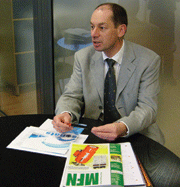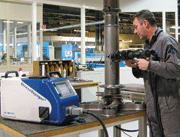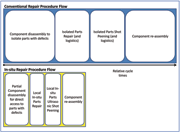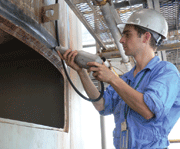E-Archive
Interview
in Vol. 11 - March Issue - Year 2010
Improve The Fatigue Life Of Your Critical Metal Components By Using Only a Few Grams Of High Quality Beads!

Dr. Olivier Bri

Sonats in-situ local peening

In-situ treatment cycle comparison

Example of tanker rudder weld peening operation
The French company Sonats is driven by its intriguing technology. MFN wanted to know more and asked Dr. Olivier Brière, Sales Manager of Sonats, some specific questions.
(?) MFN: How would you briefly describe SONATS’ profile, expertise and solutions?
(!) O. B.: Created in 1991, SONATS is an innovative SME with headquarters located in Nantes, France. We develop innovative mechanical surface impact treatment solutions for critical metal parts. The Patented STRESSONIC® process is our core technology to provide turnkey solutions that fit our customer needs: ultrasonic shot peening, needle straightening/peen forming and needle peening of welds. Our expertise goes far beyond selling just the peening equipment or machine. We are able to develop customized solutions thanks to our engineering services, peening services (in our workshop and worldwide at customer sites), and mechanical design expertise.
Recognized, qualified, and certified (ISO9001-2000, EN9100), SONATS is committed to providing best solutions and quality for its clients.
(?) MFN: SONATS’ core technology is named STRESSONIC®. How does this innovative process differ from conventional shot peening ones?
(!) O. B.: The STRESSONIC® process aims to improve the fatigue life of metal components. It differs from conventional shot peening in the way the beads (or more generally the media) gain their energy. Our process uses the vibration of the top surface of a sonotrode to impulse the beads to the part area to be treated. The mechanical vibration is created through an acoustic chain, including a digital high precision ultrasonic generator (20kHz), a piezo-electrical converter, boosters and a sonotrode.
Another major difference with respect to the conventional shot peening is that the beads are continuously re-activated as they are kept inside the peening tool chamber. The beads move like the molecules in a gas, and hit the surface with a complete range of incidence angles. We use a few grams of high quality beads when conventional shot peening uses hundreds of kilos!
Our process is recognized as very efficient for introducing beneficial compressive stresses with a high-quality resulting surface aspect. Moreover, the low consumption of energy and shots makes this technology environment-friendly.
(?) MFN: Is the STRESSONIC® process limited only to Ultrasonic Shot Peening application?
(!) O. B.: Not at all, since this technology has been developed and optimized, other impact treatment applications have been based on the same ultrasonic activation principle:
Ultrasonic Needle Straightening (UNS) or Peen Forming consists of throwing rounded-head needles onto a metal part in order to modify its shape and curvature by introducing local surface compressive stresses. This technique is popular, for example, for precise straightening of large Aluminum aerostructures after machining or welding assembly.
Ultrasonic Needle Peening (UNP) consists of throwing rounded-head needles onto a weld line toe with the aim of modifying the shape of the heat affected area while introducing beneficial compressive stresses. This technique is efficient for fatigue life enhancement of welded components during original manufacture or during maintenance and repair treatment.
Other emerging applications include surface finishing (roughness reduction on component surfaces with very difficult access geometries), metal or ceramic surface or coating densification...
(?) MFN: Which are the market sectors of your end-customer applications?
(!) O. B.: End-customer applications are seen in Aerospace Engines and structures, Power Generation, Automotive, Transport, and Infrastructures markets to name only the most important.
Clear differentiating advantages of our solutions include the capability to treat difficult accessible geometries such as small and high aspect ratio bores, with dynamic and complete control of all process parameters. Our portable solutions are suitable for any on site peening requirements.
(?) MFN: Would you please focus in more detail on your innovative in-situ peening solution?
(!) O. B.: During production and assembly of highly complex components such as Airplanes or Helicopters engines, fatigue sensitive metal parts could suffer from scratches or other damage resulting from inadvertent collision or impact. These defects cannot be allowed due to their associated risks of failures. A repair procedure is systematically required. The conventional solution is to dismantle the engine, isolate the defective parts which are then repaired and shot peened (generally by a sub-contractor) in order to restore the compressive stresses. Then the engine is re-assembled.
SONATS original solution, associated to local repair processes, allows an in-situ local Ultrasonic Shot Peening without, or with only a partial, dismantlement of the engine. Obvious major savings are then made both in terms of direct costs and in terms of shorter production cycles. Thanks to our innovative STRESSVOYAGER® portable equipment in addition to dedicated peening head fixtures, we guarantee an efficient shot peening without the risk of losing any beads, and avoiding the risk of damaging the part to be treated.
As an example, our customer EUROCOPTER has chosen our flexible system to repair different sensitive parts of their helicopter rotors, while saving money and significantly reducing their repair cycle time. In addition, SONATS, with the support of its partner AVION Inc (Huntsville, AL), holds a SBIR R&D program with the aim of introducing such innovative process for the maintenance and repair of US-Army Rotorcrafts.
Other recent examples also include in-situ treatment services of fatigue sensitive parts for preventive maintenance on high power naval engines.
We are convinced that there are many opportunities in this application field of in-situ peening solution which authorizes the implementation of the process as close as possible to the end-customers.
(?) MFN: How does SONATS contribute to the establishment of technical standards?
(!) O. B.: SONATS’s delegates participate regularly to National, European and American Normalization committees. Ultrasonic Shot Peening process is now covered by the BNAE-NF-L-06-833 specification, and a SAE/AMS that should be released soon. A new specification about Ultrasonic Peen Forming is to be elaborated by a SAE/AMEC SE subcommittee.
(?) MFN: How does SONATS commercialize its solutions?
(!) O. B.: SONATS has built an efficient worldwide sales and technical network based on a sister company, SONATS Inc. in Canada. and added-value partners that bring their strong experience and expertise to advise the end-customers. Our worldwide partners are Dr Yoshihiro Watanabe (Toyo-Seiko, Japan & Eastern Asia), Andreas Haller (Schnür+Haller, Germany, Austria, Switzerland and Denmark), Paul Radulescu (Wheelabrator Group, China), Brigitte Labelle and Sylvain Forgues (MFN Contributing Editor and Scientific Advisor, Shockform, Canada), Michel Lambin (Tracosa, Russia), Achim Dasguspa (Adtech, India), and we are proud to announce that we have recently started a collaboration with Paul Huyton (Peening International, UK, Ireland), an MFN course director and trainer.
SONATS is willing to expand its commercial network and is actively seeking new partners for Northern and Southern Europe, Americas, and Oceania. We are looking for reliable companies with a good business reputation and solid contacts within at least two of these market sectors: Aerospace, Energy, Automotive, Medical, Road&Rail Infrastructures, Naval, and Heavy Industries. The partner may have technical knowledge and proven experience in Impact Surface and cold working Metal Treatments as well as in their applications. Partners should have an in-depth knowledge of market potentials in their country and have a keen interest in a long-lasting partnership. Any partner ideally should also be ready to offer on-site services within its geographical area. Don’t hesitate to contact me, if you are interested!
(?) MFN: As a conclusion, what are the main reasons for customers to choose SONATS solutions?
(!) O. B.: Customers should come first to SONATS, or via our added value partners, for our technology and expertise to identify the right solution. It will be able then to appreciate SONATS’ team expertise, reactivity, flexibility, services and products quality.
MFN would like to thank Dr. Olivier Brière for this interview.
For Information:
Sonats SA
2 rue de la Fonderie, BP 40538
44475 CARQUEFOU, France
Tel. +33.251.700 494, Fax +33.251.700 583
E-mail: sonats@sonats.com
https://sonats-et.com/en



























